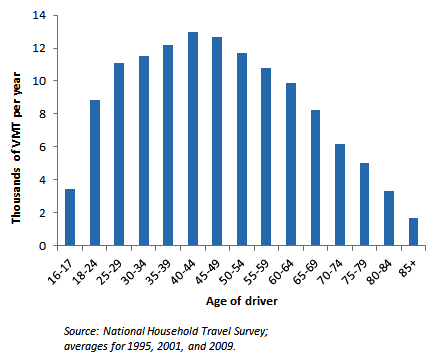The Wisconsin Department of Transportation is having a tough time justifying new highway projects when highway use is down. So now they have a new tactic – denial. They simply deny that traffic is down – and they have issued a “fact sheet” to promote their view.
1000 Friends takes a closer look at the WisDOT fact sheet and finds that not everything is quite as WisDOT says: (WisDOT “factsheet” excerpts are italicized)
Overall driving statewide:
VMT has fluctuated over the past several years, and depending on the years, scale, and locations chosen, can be shown to have either increased or decreased.
While a decreasing trend can be found in the last ten years or so, an increasing trend is found over both the last 20 years and the most recent year from 2011 to 2012.
These trends are important to consider, and WisDOT will continue to study them to see how driving habits may be changing throughout Wisconsin.
WisDOT, while admitting VMT has been declining for over a decade, does not appear to have made any serious efforts to study its underlying causes and incorporate this new information into transportation planning models. If any such studies have been carried out, they have not been made available to the public.
While the population of Wisconsin is indeed slated to increase, what is not mentioned on the flyer is that this increase will consist almost entirely of over 65 year olds.[1] According to data collected by the U.S. Census Bureau National Household Travel Survey, this is the demographic that is likely to drive the least.
In addition, WisDOT predicts up to a 40% increase in traffic – which is nowhere close to the 15% increase in population that will take place in Milwaukee County.
Traffic forecasts:
In developing forecasts for projects, WisDOT relies on data that are most closely related to the causes of traffic, like land use and development changes. WisDOT does not rely on VMT because it is not a comprehensive enough measure to predict corridor-specific traffic. VMT is not corridor-specific and only captures general driving trends.
Another consideration is that the Wisconsin Department of Administration Demographic Services Center has projected Wisconsin’s population to grow by approximately 15% from 2010 to 2040. It is likely that total VMT will continue to increase statewide.
In developing forecasts for projects WisDOT does not use VMT as a measure for long-range transportation planning claiming that it is not comprehensive enough to use at the scale of individual corridors. VMT, however is directly linked to more corridor scale measures like Average Daily Traffic (ADT) – meaning that a continuous decline in VMT is reflective of declines in traffic volume. [2]
WisDOT’s statement that total VMT will likely continue to increase statewide has no basis in reality. The main reasons for the growth in vehicle miles driven in decades past have been:
- An increasing number of women joining the workforce.
- Baby Boomers being able to afford cars and driving more.
- Huge increases in suburban populations which led to longer travel patterns.
- A decrease in average vehicle occupancy.
Each of these factors, today no longer are relevant. Women currently are projected to outnumber men in the workforce.[3] Baby Boomers are retiring and young people today do not drive at the rates their parents and grandparents did.[4][5] People are moving back to cities, with many studies indicating that we may never return to living in suburbs like earlier.[6] Average vehicle occupancy fell from 1.9 passengers per vehicle in 1969 to 1.55 in 2009. Keeping these trends in mind, we are hard pressed to see how there will be a return to earlier rates of VMT growth.
In addition, the state has not invested in using modern technology to better understand trip origins and destinations – a crucial component of travel demand modeling. Companies like Airsage now carry out analyses using traveler mobile devices and are able to accurately record usage on corridors like the one under consideration. Any money invested in understanding travel patterns will reap manifold benefits through a more optimal use of billions of dollars of taxpayer money.
Long-term nature of freeway work:
It is important not to overreact to short-term trends. In 1978, after many years of growth, Wisconsin’s VMT peaked at almost 35 billion. VMT then fluctuated for several years before finally surpassing that number in 1984. After 1984, VMT in Wisconsin increased for 20 consecutive years to 60 billion.
Roads are designed to last a long time – the typical planning horizon is 20 years into the future after construction and roadway life expectancy is even longer. In 2012 VMT in Wisconsin was 11.5 billion more than it was in 1992. Despite occasional short duration decreases, Wisconsin’s VMT has never declined over any 20-year span.
WisDOT claims that VMT fluctuated for a period after 1978, before recovering to earlier growth levels in 1984 – and therefore we must be careful before reacting to similar trends today. This is indicative of WisDOT’s mindset being stuck in decades past. Wisconsin’s travel trends are in line with the rest of the country’s – with several research reports and studies concluding that these changes are permanent. In any case, a 10 year decline is unprecedented in the state’s history.
If we continue to disregard these changes and continue to plunge billions of dollars into highway expansion projects, we run the risk of building white elephants that our children will have to pay for, without ever using them. Instead of pointing to data from the 1970’s – WisDOT should take a progressive view and move away from the “highways department” mentality it is clearly entrenched in.

At a time when young people are demanding more transportation options, widening stretches of roadway every time there is a congestion problem is unsustainable financially and environmentally. It has been proven time and again that we cannot build our way out of congestion. While other states are looking at innovative solutions to manage travel demand, Wisconsin is trying to fit 1970’s era solutions for 21st century problems. Providing transportation options that encourage the use of non-automobile modes of travel will reduce the number of cars on the road and cost significantly less than the proposed $1.2 billion for expanding the highway.
DOT emphasizes the long-term nature of freeway work – this is indeed true, and even more reason to carefully study trends before sinking money into projects that will last over quarter of a century. The state does not take into account the costs needed to maintain and operate the highway after the expansion, instead only budgeting for the upfront costs of construction. This is akin to buying a car without worrying about how to pay for gas. It is hard to see how a boondoggle like the proposed expansion is the best possible way to spend our increasingly scarce transportation dollars.
-Ash Anandanarayanan, Transportation Policy Analyst
Sources:
- Wisconsin’s Future Population, Projections for the State, Its Counties and Municipalities, 2010 – 2040, Wisconsin Department of Administration, Demographic Services Center. https://www.doa.state.wi.us/Divisions/Intergovernmental-Relations/Demographic-Services-Center/Wisconsin-Population-Projections/
- https://docs.lib.purdue.edu/cgi/viewcontent.cgi?article=1685&context=jtrp
- https://www.dol.gov/wb/factsheets/Qf-laborforce-10.htm
- https://www.businessinsider.com/baby-boomers-are-retiring-2014-2
- https://uspirg.org/reports/usp/new-direction
- https://www.citylab.com/housing/2012/04/end-sprawl/1692/

